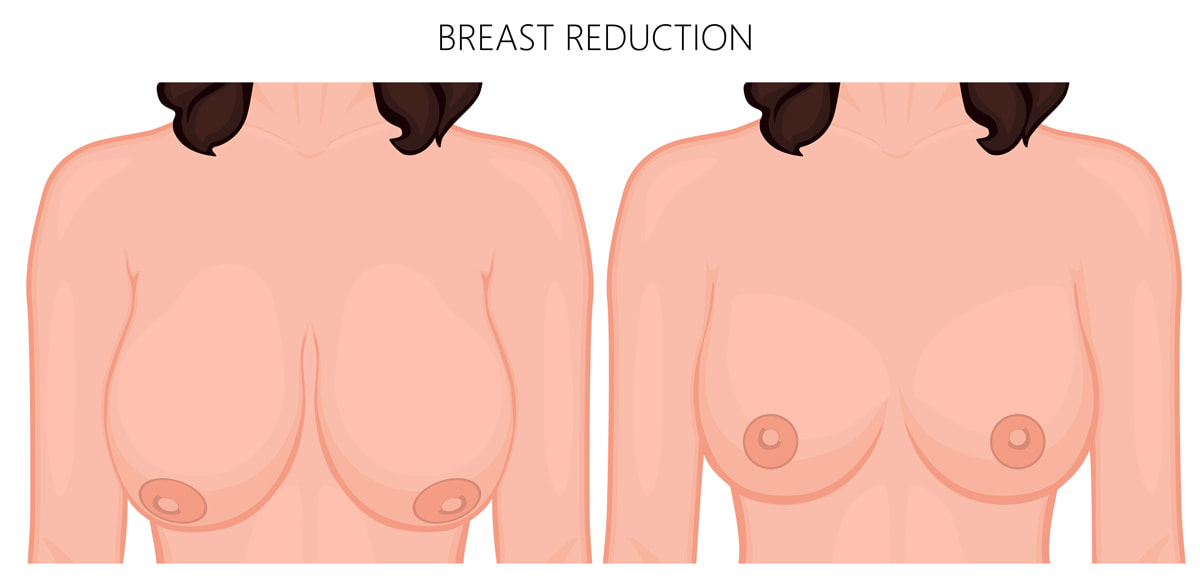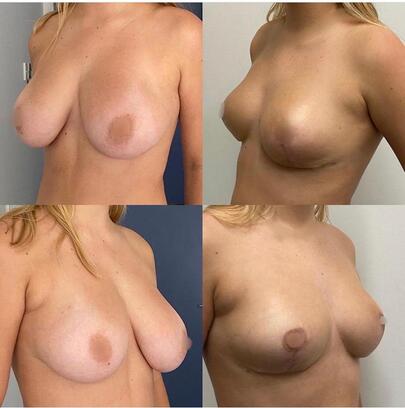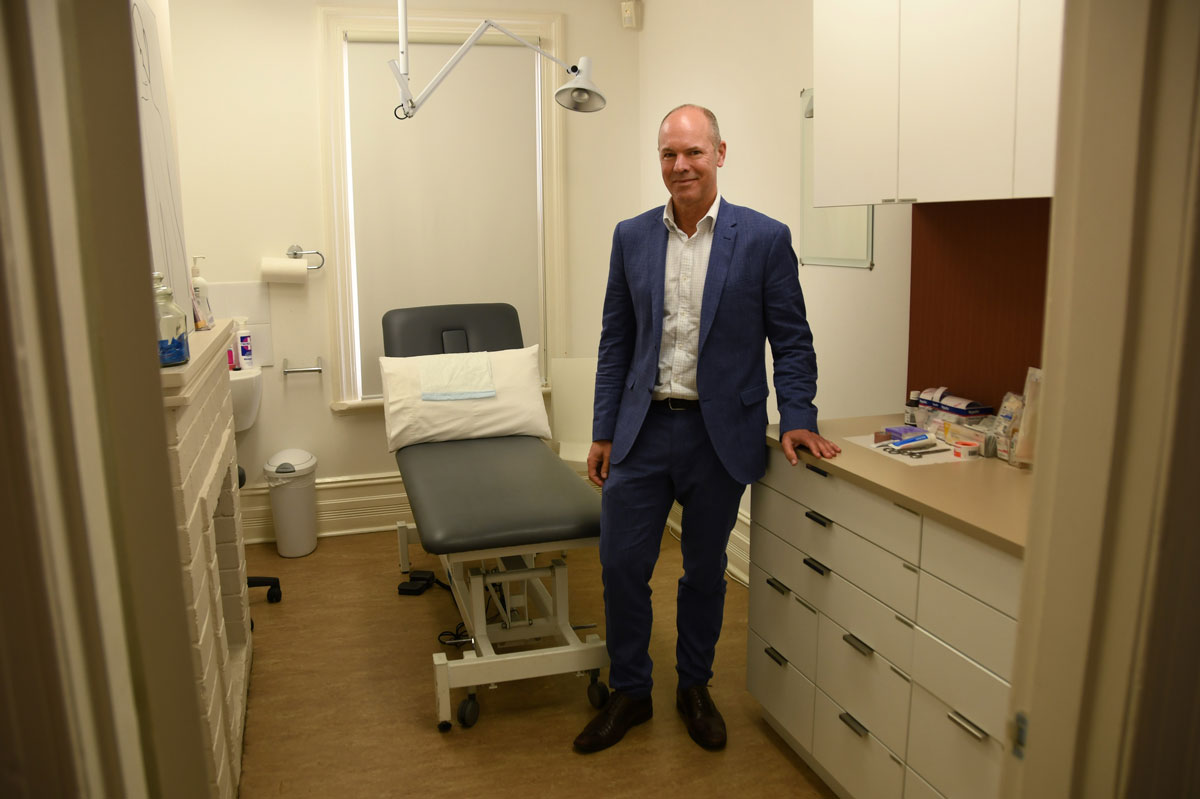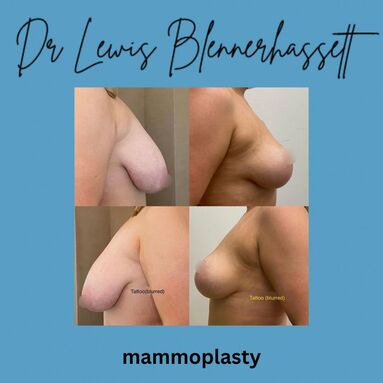What is Breast Reduction Surgery?
Breast reduction is a surgical procedure chosen by patients with overly large breasts to address pain, discomfort, inability to exercise and other issues linked to breast size.
Breast reduction, known also as reduction mammoplasty, takes several hours to perform and reduces the size of the breast through the removal of excess breast fat, glandular tissue and skin.
This results in breasts more in proportion with the size of the body and less prone to pain and discomfort.
It also lifts and tightens the breasts, which are often sitting lower than desirable. The size of the areolas is also reduced.
Commonly used terms - surgery for large breasts, smaller breasts, smaller boobs, back pain from heavy breasts, neck pain from heavy breasts, shoulder pain from heavy breasts.
Breast reduction, known also as reduction mammoplasty, takes several hours to perform and reduces the size of the breast through the removal of excess breast fat, glandular tissue and skin.
This results in breasts more in proportion with the size of the body and less prone to pain and discomfort.
It also lifts and tightens the breasts, which are often sitting lower than desirable. The size of the areolas is also reduced.
Commonly used terms - surgery for large breasts, smaller breasts, smaller boobs, back pain from heavy breasts, neck pain from heavy breasts, shoulder pain from heavy breasts.
Dr Lewis Blennerhassett – breast reduction surgeon
|
Highly experienced in this procedure, Dr Lewis Blennerhassett is a skilled breast reduction surgeon and respected Specialist Plastic Surgeon and has performed breast reduction surgery for more than 25 years.
His breast reduction work is focused on being meticulous and precise, prioritising safety and quality. His breast reductions are performed only in fully accredited, fully equipped hospitals. His anaesthetists are skilled and highly qualified. Breast reduction care offered by Dr Blennerhassett is highly individualised and based on your needs. After a comprehensive and thorough discussion with you, he will personally work with you on your operation plan. A great communicator, he oversees all patient care, from the first consultation until full recovery. Dr Lewis Blennerhassett (MED0001532372), registered medical practitioner. Specialist Plastic Surgeon, Specialist registration in Surgery – Plastic Surgery *Be aware that some doctors performing breast surgery are not Specialist Plastic Surgeons |
Why is Breast Reduction Surgery performed?
Breast reduction surgery is generally considered a reconstructive procedure and may be partially covered by private health insurance. Dr Blennerhassett will be able to advise on this.
Women seek breast reduction surgery with breast reduction surgeon Dr Lewis Blennerhassett for many reasons, for example:
Below Before and After Breast Reduction
Reduction mammoplasty
Post op image - three months post surgery.
Reminder, outcomes shown are only relevant for this patient and do not necessarily reflect the results other patients may experience, as results may vary due to many factors including the individual’s genetics, diet and exercise
Women seek breast reduction surgery with breast reduction surgeon Dr Lewis Blennerhassett for many reasons, for example:
- Symptoms due to the heaviness of the breasts e.g. shoulder and neck pain, headaches, back pain, indented shoulders from bra straps, breast pain.
- Rash beneath the breasts – called Intertrigo
- Difficulty exercising
- Difficulty buying suitable clothing off the rack
Below Before and After Breast Reduction
Reduction mammoplasty
Post op image - three months post surgery.
Reminder, outcomes shown are only relevant for this patient and do not necessarily reflect the results other patients may experience, as results may vary due to many factors including the individual’s genetics, diet and exercise
What impacts on the size of breasts?
Breast development occurs at several key points in a woman's life: first before birth, again at puberty, and later during the childbearing years. Breasts then change again during and after menopause. After menopause, the firm glandular tissue is often replaced by fat. This may be more susceptible to weight changes of the patient.
Many factors impact on the size of the breast – including hormones and genetic background. Researchers have now identified at least seven genetic markers linked with a woman's breast size.
Many factors impact on the size of the breast – including hormones and genetic background. Researchers have now identified at least seven genetic markers linked with a woman's breast size.
Is Breast Reduction Surgery right for you?
Women of all ages seek opinions from breast reduction surgeon Dr Lewis Blennerhassett about their suitability for this procedure. The decision as to whether to go ahead involves considering individual needs and a range of factors, including patient general health and other medical histories relevant to having general anaesthesia (being asleep for the surgery).
Dr Blennerhassett will address all of this with you at the first consultation. He will take a comprehensive history, examine you and fully explain your surgery requirements, risks and expectations. You will also be given information sheets to take home and read for additional information and to reinforce what has been discussed.
Generally, breast reduction surgeon Dr Lewis Blennerhassett follows the below guidelines from the Australian Society of Plastic Surgeons.
Breast reduction may be a good option for you if:
Dr Blennerhassett will address all of this with you at the first consultation. He will take a comprehensive history, examine you and fully explain your surgery requirements, risks and expectations. You will also be given information sheets to take home and read for additional information and to reinforce what has been discussed.
Generally, breast reduction surgeon Dr Lewis Blennerhassett follows the below guidelines from the Australian Society of Plastic Surgeons.
Breast reduction may be a good option for you if:
- You are physically healthy
- You have realistic expectations
- Your breasts are fully developed
- Your breasts limit your physical activity
- You experience back, neck and shoulder pain caused by the weight of your breasts
- You have regular indentations from bra straps that support heavy breasts
- You have skin irritation beneath the breast crease
- Your breasts hang low and have stretched skin
- Your nipples rest below the breast crease when your breasts are unsupported
- You have enlarged areolas caused by stretched skin.
- Your BMI is less than 30 (Dr Blennerhassett’s recommendation)
What does Breast Reduction Surgery involve?
There are several key steps to performing a breast reduction operation;
Before and After Breast Reduction images
Reduction mammoplasty
Post op image - two months post surgery
Outcomes shown are only relevant for this patient and do not necessarily reflect the results other patients may experience, as results may vary due to many factors including the individual’s genetics, diet and exercise
- Design skin incisions to allow removal of breast tissue and correct breast position and symmetry
- Remove excess skin and breast tissue
- Shift nipple-areolar complexes to new location (usually higher up), whilst preserving blood supply to nipples.
- Repair breast tissue in multiple layers
- Repair skin of breasts and nipples/areolas
Before and After Breast Reduction images
Reduction mammoplasty
Post op image - two months post surgery
Outcomes shown are only relevant for this patient and do not necessarily reflect the results other patients may experience, as results may vary due to many factors including the individual’s genetics, diet and exercise
Breast Reduction Surgery Risks
From the Australian Society of Plastic Surgeons (https://plasticsurgery.org.au/)
Modern surgery is generally safe but does have the potential for risks and complications to occur, states the Australian Society of Plastic Surgeons.
Some possible complications and risks associated with breast reduction surgery may include:
Does a Breast Reduction Surgery require anaesthesia?
Breast reduction is performed under general anaesthetic, meaning you will be asleep for the procedure. Breast reduction surgeon Dr Lewis Blennerhassett ensures his breast reductions are performed only in fully accredited, fully equipped hospitals, with highly qualified skilled anaesthetists.
Modern surgery is generally safe but does have the potential for risks and complications to occur, states the Australian Society of Plastic Surgeons.
Some possible complications and risks associated with breast reduction surgery may include:
- Risks of anaesthesia including allergic reaction or potentially fatal cardiovascular complications such as heart attack
- Surgical risks such as bleeding or infection
- Breathing difficulties due to general anaesthetic or the endotracheal tube which can cause swelling, noisy breathing and discomfort
- A blood clot in the deep veins of the legs (deep vein thrombosis), which can move to the lungs (pulmonary embolus) or to the brain and may be life threatening
- Fluid accumulation around the operation site(s)
- Allergic reaction to suture materials, tape adhesive or other medical materials and lotions
- Skin discoloration, permanent pigmentation changes, swelling and bruising
- Damage to deeper structures – such as nerves, blood vessels, muscles, and lungs – can occur and may be temporary or permanent
- Fatty tissue deep in the skin could die (fat necrosis)
- Changes in breast and nipple sensation
- Temporary or permanent areas of numbness
- Asymmetry (unevenness) of the breasts
- Potential partial or total loss of nipple and areola
- Need for further surgery to treat complications
- Dr Blennerhassett will discuss your individual expectations, risks and recovery management with you in person.
Does a Breast Reduction Surgery require anaesthesia?
Breast reduction is performed under general anaesthetic, meaning you will be asleep for the procedure. Breast reduction surgeon Dr Lewis Blennerhassett ensures his breast reductions are performed only in fully accredited, fully equipped hospitals, with highly qualified skilled anaesthetists.
What do I need to do before a Breast Reduction Surgery?
Breast reduction care offered by breast reduction surgeon Dr Lewis Blennerhassett is highly individualised and based on your individual needs. After a comprehensive and thorough discussion with you, he will personally advise on what steps you need to take before your surgery.
Generally, for all patients Dr Blennerhassett recommends that;
*You will now need to first obtain a referral for cosmetic surgery from your GP. We will also get you to complete a screening questionnaire. The changes are new rulings from the Medical Board and AHPRA. They are being introduced across Australia to further support high quality care.
Generally, for all patients Dr Blennerhassett recommends that;
- You inform us of all the medications, vitamins, tonics, naturopath and alternative medicine treatments that you are taking, especially medications that may increase your likelihood of bleeding.
- You organise about 2-3 weeks off work and a similar amount of time away from sport.
- You arrange for a friend or family member to pick you up from the hospital the day after surgery.
- You arrange for a friend or family member to stay with you for at least 2 to 3 days after you leave the hospital.
*You will now need to first obtain a referral for cosmetic surgery from your GP. We will also get you to complete a screening questionnaire. The changes are new rulings from the Medical Board and AHPRA. They are being introduced across Australia to further support high quality care.
What age can a Breast Reduction Surgery be done?
Generally, a breast reduction is best done once breast development is complete. However, any age is appropriate for surgery if the patient is experiencing significant symptoms. Dr Blennerhassett has had patients ranging from young adults to 75-year-olds.
Breast Reduction Before and After images
Reduction mammoplasty
Post op image - two months post surgery
Outcomes shown are only relevant for this patient and do not necessarily reflect the results other patients may experience, as results may vary due to many factors including the individual’s genetics, diet and exercise
Breast Reduction Before and After images
Reduction mammoplasty
Post op image - two months post surgery
Outcomes shown are only relevant for this patient and do not necessarily reflect the results other patients may experience, as results may vary due to many factors including the individual’s genetics, diet and exercise
What does a Breast Reduction Surgery first consultation involve?
|
At your first visit, breast reduction surgeon Dr Lewis Blennerhassett will discuss your concerns and requirements, and an operative plan will be formulated specifically for you. A thorough physical assessment is necessary, as well as a detailed discussion of the expected outcomes from the surgery for each individual patient. A comprehensive discussion of the relevant risks and side effects of the procedure will also take place.
At this point, we can also show you patient-approved “before and after” photographs of other breast reduction cases, if you wish to see them. |
Once an operative plan has been formulated, an accurate estimate of the costs involved can be given to you. This will take into account the cost of the operation, the anaesthetic and also the hospital fees.
If you decide to proceed with the operation, the next step is to find a suitable date that fits in with you. Our practice staff - Tara, Domenica and Paula - will be able to assist with this.
Second Consultation - You will then come back for a second visit prior to your surgery. This is so you have an opportunity to ask any questions you may not have thought of at the first visit and so everything is still fresh in your mind for the day of surgery. For this reason, the second visit is usually close to the date of surgery.
If you decide to proceed with the operation, the next step is to find a suitable date that fits in with you. Our practice staff - Tara, Domenica and Paula - will be able to assist with this.
Second Consultation - You will then come back for a second visit prior to your surgery. This is so you have an opportunity to ask any questions you may not have thought of at the first visit and so everything is still fresh in your mind for the day of surgery. For this reason, the second visit is usually close to the date of surgery.
What will happen on the day of my Breast Reduction Surgery?
On the day of the surgery, you will be admitted to the hospital by the nursing staff and prepared for the operating theatre. Dr Blennerhassett will visit you on the ward before the operation to measure and mark the skin for your surgery. The surgery may take several hours.
You will spend 1 to 2 nights in hospital, and will have dressings changed prior to going home.
This is general recovery advice for educational purposes only. Dr Blennerhassett will discuss your individual expectations and recovery management with you.
You will spend 1 to 2 nights in hospital, and will have dressings changed prior to going home.
This is general recovery advice for educational purposes only. Dr Blennerhassett will discuss your individual expectations and recovery management with you.
What do I need to do after a Breast Reduction Surgery?
Breast reduction surgeon Dr Lewis Blennerhassett prides himself on his high-quality aftercare, which is overseen personally by him with the assistance of our highly experienced practice nurse.
Dressings changes carried out by our expert nurses will take place at Dr Blennerhassett’s Subiaco Plastic Surgery rooms until all healing is complete. You will need about 2-3 weeks off work, and a similar amount of time away from sport.
During the recovery period, Dr Blennerhassett will be contactable to answer your questions. His mobile number will be provided to you during pre-surgery consultations.
Dressings changes carried out by our expert nurses will take place at Dr Blennerhassett’s Subiaco Plastic Surgery rooms until all healing is complete. You will need about 2-3 weeks off work, and a similar amount of time away from sport.
During the recovery period, Dr Blennerhassett will be contactable to answer your questions. His mobile number will be provided to you during pre-surgery consultations.
What are the Aftercare costs for Breast Reduction Surgery?
All of your post-op aftercare is covered in your surgical fee, you do not have to pay extra for this. This includes the removal of sutures, changing of dressings etc. and advice on wound care and recovery. If you have a new problem, a new referral is necessary. This is a Medicare requirement.
Breast Reduction Surgery words to know
(Source: Australian Society of Plastic Surgeons Glossary)
Excision: to remove the skin
Areola: pigmented skin surrounding the nipple
Reduction mammaplasty: breast reduction, a surgical procedure that removes excess breast tissue to reshape the breast
General anaesthesia: Drugs and/or gases used during an operation to relieve pain and alter consciousness
Sutures: Stitches used by surgeons to hold skin and tissue together
(Source: Australian Society of Plastic Surgeons Glossary)
Excision: to remove the skin
Areola: pigmented skin surrounding the nipple
Reduction mammaplasty: breast reduction, a surgical procedure that removes excess breast tissue to reshape the breast
General anaesthesia: Drugs and/or gases used during an operation to relieve pain and alter consciousness
Sutures: Stitches used by surgeons to hold skin and tissue together
Reduction mammoplasty before and after. At 3 months post op
Note position in relation to tattoo on side view for indication of the degree of lift achieved (tattoo blurred for confidentiality).
*Individual results will vary from patient to patient and according to factors including genetics, age, diet and exercise.
*All invasive surgery carries risk and requires a recovery period and care regimen.
Note position in relation to tattoo on side view for indication of the degree of lift achieved (tattoo blurred for confidentiality).
*Individual results will vary from patient to patient and according to factors including genetics, age, diet and exercise.
*All invasive surgery carries risk and requires a recovery period and care regimen.








